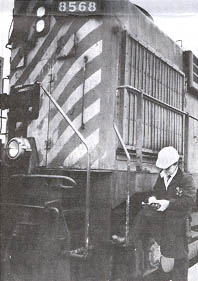
Public Relations and
Advertising Department
Windsor Station Montreal Que. H3C
3E4
|
Volume 10
Number 2
|
Feb. 6,
1980
|
The Atlantic Limited
is Gone,
and Nobody Waved Good-Bye
Stephen
Morris
| |

Preparing to
go: The Atlantic Limited, once the pride of the railway's
east coast passenger service, ended more than 90 years service
recently when it left Central Station in Montreal for Saint John,
New Brunswick.
|
Another chapter has
been written in the history of passenger trains in Canada.
And nobody noticed.
With overcast skies and biting cold the Atlantic Limited has gone to
Saint John, N.B. It has had its last complete trip over CP Rail lines.
The train, once the pride of the railway's east coast passenger service
has ended more than 90 years service.
The Atlantic, as it now will be called by VIA Rail Canada, departed at
Central Station in Montreal and used CN Rail tracks as far as Lennoxville,
Que., before switching back to CP Rail trackage for the remainder of the
trip to Saint John.
CP Rail began passenger service to Saint John in July, 1889 over the
company's tracks as far as the U.S. border. The train then operated over
Maine Central tracks to McAdam, N.B., and continued its journey on the
New Brunswick Railway to Saint John.
The New Brunswick Railway was bought in 1890 and the maine Central
trackage in the early 1970s.
Using 4-4-0 class locomotives, the early trains featured
first-class coaches and sleepers built specially for the
service.
The "new" run-through train being operated by VIA
Rail, which sees The Atlantic continue its journey to Halifax instead of
terminating at Saint John, was once before a regular service.
Until World War I, CP Rail operated three extra sleepers on the train
which continued on the Intercolonial Railway from Saint John to Halifax.
In the 1940's and 50's, CP Rail operated two trains a day in each
direction between the two cities. Train 40 left Montreal for Saint John
in mid-afternoon while train 42 left in the early evening.
Sister train 39 from Saint John arrived in Montreal about 11:00 hours
and train 41 entered Windsor Station in the evening.
Generally the railway used 2300 or 2400 series G3 class
4-6-2 type steam engines on the service.
CP Rail's only two Northern steam locomotives 3100 and 3101 were assigned
to the service in the 1950's but only for a short period as they had
nickel-steel boilers which prohibited them from operating on
the United States portion of the track.
Pensioners recalled during this period four of the last "J"
class sleepers were assigned to this service. The four - Jaffray, Jackman,
Jelicoe, and Joliette contained 14 sections of upper and lower berths.
The Atlantic Limited also had the distinction of pulling the last CP Rail
"T" class sleepers, Tracy and Travers until 1969.
The main reason for these types of cars being assigned to the Saint John
run was most passengers in those days preferred the upper or lower berths
not because of comfort, but because of cost.
Service to Saint John was reduced to one train about the same time that
dieselization took place in 1960.
It was also during that period the train was officially named "The
Atlantic Limited".
Railway historians note that the use of "Limited" in the naming
of the train was incorrect. The word originated in the early years of the
railway and meant that the train was limited to first class passengers
or accommodation only.
The train more recently became well-known to rail
enthusiasts as it was powered by the only two E8 class diesel locomotives
owned by a Canadian railway. Diesel units 1800 and 1802 were familiar
sights pulling the one baggage car, one coach, one diner, and trailing
sleeper.
The new VIA Rail service also sees the re-introduction of a
stop at a new station named Mill Street in Saint John. CP Rail's terminal
at West Saint John, which served as the main terminal when the
100-year-old Mill Street Union Station was demolished will
no longer be used as a passenger station.
This CP Rail News article is copyright 1980 by
Canadian Pacific Railway and is reprinted here with their permission. All
photographs, logos, and trademarks are the property of the Canadian
Pacific Railway Company.
|